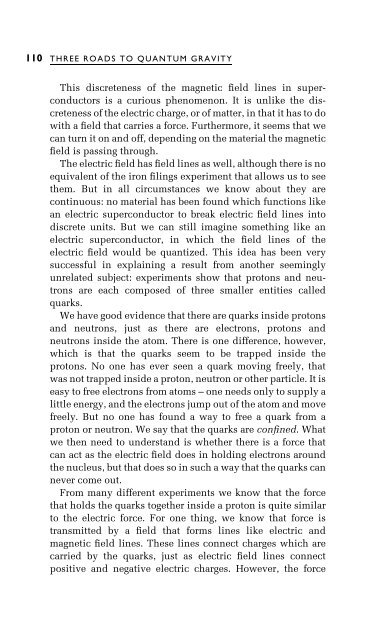Three Roads To Quantum Gravity
Three Roads To Quantum Gravity
Three Roads To Quantum Gravity
Create successful ePaper yourself
Turn your PDF publications into a flip-book with our unique Google optimized e-Paper software.
110 THREE ROADS TO QUANTUM GRAVITY<br />
This discreteness of the magnetic ®eld lines in superconductors<br />
is a curious phenomenon. It is unlike the discreteness<br />
of the electric charge, or of matter, in that it has to do<br />
with a ®eld that carries a force. Furthermore, it seems that we<br />
can turn it on and off, depending on the material the magnetic<br />
®eld is passing through.<br />
The electric ®eld has ®eld lines as well, although there is no<br />
equivalent of the iron ®lings experiment that allows us to see<br />
them. But in all circumstances we know about they are<br />
continuous: no material has been found which functions like<br />
an electric superconductor to break electric ®eld lines into<br />
discrete units. But we can still imagine something like an<br />
electric superconductor, in which the ®eld lines of the<br />
electric ®eld would be quantized. This idea has been very<br />
successful in explaining a result from another seemingly<br />
unrelated subject: experiments show that protons and neutrons<br />
are each composed of three smaller entities called<br />
quarks.<br />
We have good evidence that there are quarks inside protons<br />
and neutrons, just as there are electrons, protons and<br />
neutrons inside the atom. There is one difference, however,<br />
which is that the quarks seem to be trapped inside the<br />
protons. No one has ever seen a quark moving freely, that<br />
was not trapped inside a proton, neutron or other particle. It is<br />
easy to free electrons from atoms ± one needs only to supply a<br />
little energy, and the electrons jump out of the atom and move<br />
freely. But no one has found a way to free a quark from a<br />
proton or neutron. We say that the quarks are con®ned. What<br />
we then need to understand is whether there is a force that<br />
can act as the electric ®eld does in holding electrons around<br />
the nucleus, but that does so in such a way that the quarks can<br />
never come out.<br />
From many different experiments we know that the force<br />
that holds the quarks together inside a proton is quite similar<br />
to the electric force. For one thing, we know that force is<br />
transmitted by a ®eld that forms lines like electric and<br />
magnetic ®eld lines. These lines connect charges which are<br />
carried by the quarks, just as electric ®eld lines connect<br />
positive and negative electric charges. However, the force



![arXiv:1001.0993v1 [hep-ph] 6 Jan 2010](https://img.yumpu.com/51282177/1/190x245/arxiv10010993v1-hep-ph-6-jan-2010.jpg?quality=85)


![arXiv:1008.3907v2 [astro-ph.CO] 1 Nov 2011](https://img.yumpu.com/48909562/1/190x245/arxiv10083907v2-astro-phco-1-nov-2011.jpg?quality=85)








![arXiv:1002.4928v1 [gr-qc] 26 Feb 2010](https://img.yumpu.com/41209516/1/190x245/arxiv10024928v1-gr-qc-26-feb-2010.jpg?quality=85)
![arXiv:1206.2653v1 [astro-ph.CO] 12 Jun 2012](https://img.yumpu.com/39510078/1/190x245/arxiv12062653v1-astro-phco-12-jun-2012.jpg?quality=85)
